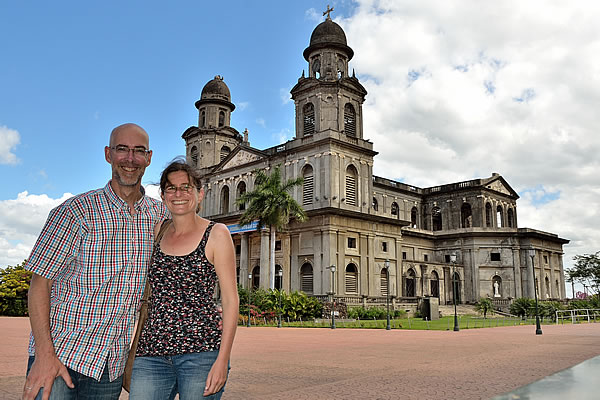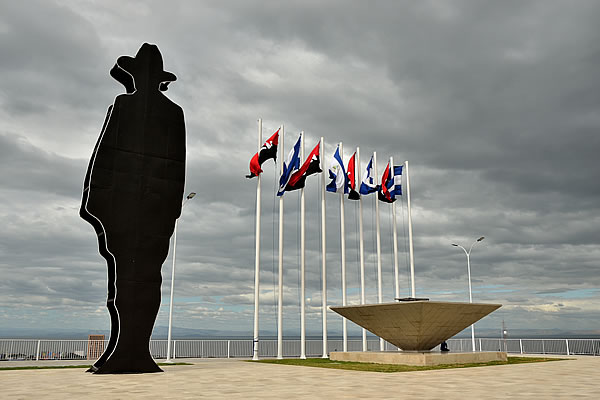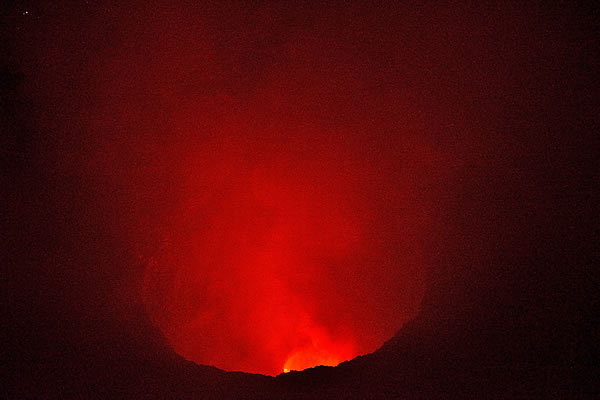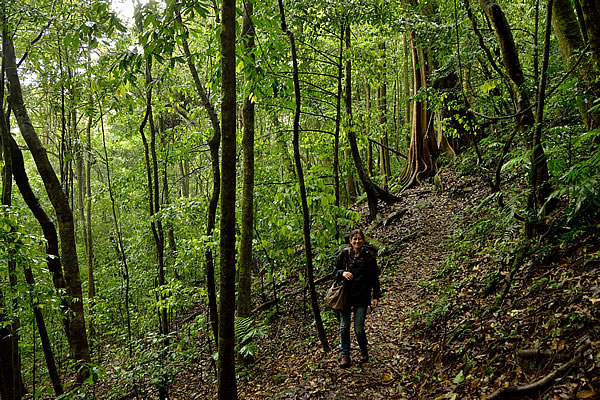

| Enjoying Nicaragua | |
Léon (Nicaragua) to El Castillo (Nicaragua), February 2018
|
|
|
|
|
After we saw for the first time in our life lava boiling in a crater at the Masaya volcano, we left Granada. We remained on the Nicaraguan tourist trail and took the public bus towards Ometepe: an Island containing two volcanoes in the immense Lago Nicaragua. For many travellers, who only briefly stay in the country, this stretch is the only experience with Nicaraguan public transport; the so-called ‘chicken bus’. These chicken buses are often old American school buses that are fully packed with people and goods, and in where sellers try to find their way through the aisle to sell their goods; from street food to drinks and from nail clippers to medication. The old American school buses are designed to transport little children, and not full sized American and European tourists. This means that the legroom is very limited. This is a good opportunity to see how our fellow travellers, who are normally traveling by air-conditioned minivans between the tourist hotspots, deal with this situation. When we enter the bus we see that a male backpacker holds a seat for his girlfriend, who is standing outside the bus enjoying a cigarette. When she comes in, the drama queen starts complaining when she sees her seat. “What a shitty place!”. “Do I really have to sit on that terrible place for two hours!”. The girl is about 20 years old, 25 inches shorter than Edwin, but crying like a spoiled baby. What we further notice is that many travellers want to have a window seat. So travel couples split up, both take a window seat, and demonstratively put their bag next to them on the bench to show that the seat is ‘taken’. Some travellers put ear phones in their ears and start looking outside or on their devices, without removing their bags, even if the aisle of the bus fills up with other passengers. We hear one guy telling his companion traveller that “Nicaraguans have a bad smell”. The bus route from Granada to Rivas (for the connection to Isla Ometepe), is popular among backpackers and that means that the price is inflated. The bus boy even asked us to pay extra for our luggage, a novelty for us in Central America. When we disembark the bus in Rivas, we are jumped by a horde taxi drivers. Illegal taxi drivers off course. After some negotiations, one of them brings us to the harbour of San Jorge, where we take the boat to Ometepe. The Island is quite tourist, but it still is an enjoyable place. We hike, watch beautiful birds and encircle the island on a rented scooter (see also the Photo impression: Isla Ometepe). After Isla Ometepe, we decide that it is the time to leave the busiest part of the tourist trail. We spend a few days in the vast capital Managua. In 1972 a huge part of the city is flattened by a terrible earthquake. President Somoza filled his pockets with international aid funds and fanned thereby Sandinista revolution, which was followed by the Contra War. The result was that the city centre was never really rebuilt, which means that you still see large bare pieces of land in the city centre. These are the places where driving schools take their students to practice driving without the risk of hitting something or somebody. But the last decade, some building activities are on their way, like the Boulevard on the shore of Lago Managua. It gives the city a nicer appearance and the Managuans that we spoke are proud of the latest developments. |
|
 |
|
Us posing in front of the empty shell of Managua's Cathedral |
|
The city of Matagalpa is our next destination. We visit the cloud forests north of the city, where the hiking is beautiful and the birds are spectacular. We visit the forest on two consecutive days. On the second day we have quite a lot of rain and the whole forest is covered in grey clouds, but at least we have a ‘real’ experience how a cloud forest look likes. After a stop-over in the friendly town Juigalpa, we take the bus to small town of El Rama. From here we take the boat to Bluefields (see also column: ‘Arriving like a 1980’s popstar in Bluefields’). The boat is the only way to the city if you do not want to take the plane. The Caribbean Coast is a very different Nicaragua, where a large portion of the Nicaraguan Creole people live. Most of them earn their money with fishing, and most of them speak English. And that is nice! Lagunas Perlas (Pearl lagoon) is 1.5 hours by boat from Bluefields and this is really a Creole enclave. It’s a very small village, also depending on fishing activities, and this is the Caribbean Coast as we have imagined it. Super tropical and picturesque. It would be nice if more tourists decide to come here, because the people here can use some extra money. We find the Creole people here very friendly and hospitable. And the food is delightful; Coconut rice with beans and fish balls in a delicious sauce, is the speciality here. It’s simple but tasty! (See also the Photo impression: Nicaragua’s Caribbean Coast). Once daily, there is a slow bus over the dirt road from Lagunas Perlas back to El Rama. Here we leave the Creole ‘territory’ again and after a week of Creole culture, we are back in the ordinary Nicaragua again. |
|
 |
|
A viewpoint in Managua, with a huge Sandinista statue |
|
|
Our last real destination in Nicaragua, before crossing over to Costa Rica, is Rio San Juan. The gateway to this river, who forms partly the border with Costa Rica, is the town San Carlos. Here in San Carlos we meet the Dutch couple Theo and Riky, who also use San Carlos as a stepping stone to El Castillo, a few hours downstream by river boat. We have a good meal together, drink a cold beer and have a good chat. In the village El Castillo, we arrange a nine-hour boat/hiking trip to the Indo Maiz nature reserve. We leave at half past six in the morning, and take the canoe to the Refugio Bartola, one of the few parts of the Indo-Maiz Reserve that can be visited by travellers (See also the Photo impression: Rio San Juan). We decided to do a part of the tour by silent canoe, to see more birds and that was a good idea. In Bartola we swapped our shoes for rubber boots because the trails in this wet part of Nicaragua are very muddy. The second growth forest is not very beautiful, and way too dense to see a lot of wildlife. We were not really impressed by this part of the reserve. When we asked about it, the guide told us that the forest is largely destroyed by a hurricane a few years back. So if you decide to come to El Castillo / Rio San Juan, you better do it for the village life along the river, and not for spectacular nature. We still enjoyed the trip very much and it was an interesting end of our visit to Nicaragua. |
|
 |
|
The busy market of Granada |
|
 |
|
A peek in the crater of the Masaya Volcano |
|
 |
|
Arrival by ferry on Isla Ometepe |
|
 |
|
Lunch spot with view on the Maderas Volcano on Isla Ometepe
| |
 |
|
A hike in the wet and dark cloud forest of Selva Negra (Black Forest) near Matagalpa © copyright - Babakoto.eu / 2018 |
|